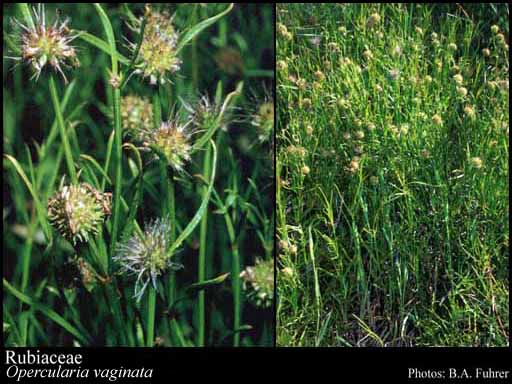- Reference
- Gen.Pl. [Jussieu] 196 (1789)
- Name Status
- Current

Scientific Description
Common name. Madder Family.
Habit and leaf form. Trees and shrubs (mostly), or lianas, or herbs, or herbaceous climbers (the herbs mostly with tetragonous, knotted stems). Young stems tetragonal. Self supporting, or epiphytic, or climbing. Helophytic, or mesophytic, or xerophytic, or hydrophytic (Limnosipanea). Leaves opposite (nearly always, and decussate), or whorled (or at least ostensibly so, seemingly representing paired leaves with enlarged, leaflike interpetiolar stipules — and rarely ostensibly alternate, through suppression of one member of each pair); petiolate to sessile; connate (often, via the stipules), or not connate; gland-dotted, or not gland-dotted; simple; epulvinate. Leaf blades entire; one-veined, or pinnately veined; cross-venulate. Leaves with stipules. Stipules interpetiolar (usually, typically the stipules internally bearing mucilage-secreting ‘colleters’), or intrapetiolar; with colleters (secreting mucilage) (usually), or without colleters. Leaf blade margins entire, or serrate. Leaves without a persistent basal meristem. Domatia recorded (frequently), or not recorded; represented by pits (mostly), or pockets, or hair tufts. Stem anatomy. Nodes unilacunar, or tri-lacunar. Secondary thickening developing from a conventional cambial ring (nearly always), or anomalous (concentric cambia recorded only in Basanacantha, ‘Chiococca’); via concentric cambia.
Reproductive type, pollination. Fertile flowers hermaphrodite, or functionally male and functionally female, or functionally male, or functionally female, or hermaphrodite, functionally male, and functionally female. Unisexual flowers present (rarely), or absent. Plants hermaphrodite (usually), or monoecious, or polygamomonoecious, or dioecious. Plants often heterostylous. Entomophilous. Pollination mechanism conspicuously specialized (with passive pollen presentation involving stylar modification), or unspecialized.
Inflorescence and flower features. Flowers aggregated in ‘inflorescences’, or solitary (less often); in cymes, or in panicles, or in verticils, or in heads (rarely, e.g. Morindeae, Gardenieae). The terminal inflorescence unit cymose. Flowers small, or medium-sized; regular; mostly 4 merous, or 5 merous; cyclic; tetracyclic. Free hypanthium absent. Perianth with distinct calyx and corolla, or petaline (the calyx often absent or almost so); 7–15; 2 -whorled, or 1 -whorled; the two whorls isomerous. Calyx when detectable 4, or 5; 1 -whorled; polysepalous (but epigynous), or gamosepalous (the lobes varying from practically lacking to enlarged and brightly coloured); entire, or lobed; when neither polysepalous nor entire, lobulate, or blunt-lobed, or toothed; open in bud; regular (mostly), or unequal but not bilabiate, or bilabiate; persistent, or not persistent; accrescent, or non-accrescent. Epicalyx present, or absent. Corolla (3–)4, or 5, or 8–10; 1 -whorled; gamopetalous; imbricate, or valvate, or contorted; tubular, or hypocrateriform; regular, or bilabiate (rarely). Fertile stamens present, or absent (when flower female). Androecium 4, or 5. Androecial members adnate (to the corolla tube); free of one another (usually), or coherent (occasionally, via the anthers); 1 -whorled. Androecium exclusively of fertile stamens. Stamens 4, or 5; isomerous with the perianth; oppositisepalous. Anthers cohering (occasionally), or connivent, or separate from one another; dehiscing via pores, or dehiscing via longitudinal slits (mostly); introrse; tetrasporangiate. Pollen shed in aggregates (in the Gardenieae), or shed as single grains (mostly); when aggregated, in tetrads. Fertile gynoecium present, or absent (when flower male). Gynoecium 2(–9) carpelled. The pistil 1 celled (rarely), or 2(–9) celled. Carpels usually reduced in number relative to the perianth. Gynoecium syncarpous; synovarious to eu-syncarpous; inferior (nearly always), or superior (only Gaertnera and Pagamea). Ovary unilocular, or plurilocular; 1 locular (rarely e.g. Gardenia), or 2(–9) locular. Gynoecium when bilocular (i.e. usually), transverse. Epigynous disk often present. Gynoecium stylate. Styles 1 (often simple), or 2(–5); free, or partially joined; attenuate from the ovary, or from a depression at the top of the ovary; apical; shorter than the ovary at anthesis to much longer than the ovary at anthesis. Stigmas wet type, or dry type; papillate, or non-papillate; Group II type and Group IV type. Placentation when unilocular, parietal; when two or more locular, axile. Ovules in the single cavity when unilocular, 6–100 (‘many’); 1–50 per locule (commonly one (Rubioideae), to ‘many’); pendulous, or horizontal, or ascending; anatropous, or hemianatropous.
Fruit and seed features. Fruit fleshy, or non-fleshy; dehiscent, or indehiscent, or a schizocarp. Mericarps when schizocarpic comprising achenes, or comprising nutlets, or comprising drupelets. Fruit when non-schizocarpic a capsule, or a berry, or a drupe. Capsules septicidal, or loculicidal, or circumscissile (e.g. Mitratheca). Fruit 1–30 seeded. Seeds endospermic (usually), or non-endospermic (Guettardinae). Endosperm ruminate, or not ruminate; when present, oily. Seeds winged (rarely), or wingless. Cotyledons 2. Embryo achlorophyllous (8/11); straight (usually), or curved. Seedling. Germination phanerocotylar, or cryptocotylar.
Physiology, biochemistry. Aluminium accumulation demonstrated, or not found. Photosynthetic pathway: C3.
Geography, cytology, number of species. World distribution: cosmopolitan. X = (6-)9/11(-17). 6000 species.
Economic uses, etc. Sources of coffee (Coffea), quinine (Cinchona, ipecac (Cephaelis), and many ornamentals (e.g. Gardenia, Rubia, Mitchella, Coprosma.